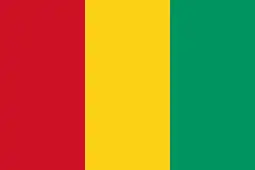Liberté (anthem)
"Liberté" (Pulaar: 𞤐𞤁𞤋𞤃𞤓; "Freedom") is the national anthem of Guinea. Adopted upon independence in 1958, it was arranged by Fodéba Keïta and is based on the melody of a Maninka praise song by Korofo Moussa for 19th-century Fouta Djallon king Alpha Yayo Diallo.
| English: Freedom | |
|---|---|
 | |
National anthem of | |
| Lyrics | Original: Korofo Moussa, 1904 Modern: Fodéba Keïta and Jean Cellier, 1958 |
| Music | Original: Korofo Moussa, 1904 Modern: Fodéba Keïta, 1958 |
| Adopted | 2 October 1958 |
| Audio sample | |
U.S. Navy Band instrumental version
| |
History
Korofo Moussa's song
The music of the anthem is derived from a praise song for the late-1800s king of Labé,[1] in Fouta Djallon, Alpha Yaya Diallo (or Alfa Yaya).[2] Alpha Yaya is, along with Wassoulou Empire founder Samory Touré, considered central by Guineans to the foundation of the modern Guinean nation,[2] in part because of his fierce attempts to resist colonisation.[3]
In 1904, Alpha Yaya was one of many traditional chiefs and kings summoned to a doctrinal conference with French colonists, who were still in the process of consolidating his territory.[2][3] The chiefs each brought along a retinue for the journey; in Alpha Yaya's retinue was griot Korofo Moussa, from Kissidougou in the south of the country. Alpha Yaya arrived to the conference on its sixth day, and Korofo Moussa is said to have spontaneously improvised, along with his troupe of dancers and kora players, a praise song for Alpha Yaya after he arrived.[2][3] The song began with the line "Alpha Yaya, Mansa bè Manka" ("Alpha Yaya, mansas (kings) are not the same").[3] According to Fodéba Isto Keira, former Minister of Youth, Sports and Culture, the performance took place in the building of the modern Directorate of the Judicial Police in the Kaloum sub-prefecture of Conakry.[4]
Korofo Moussa's air quickly became popular; it was sung and played by all the griots for the rest of the conference, and within a few days it was known throughout Conakry. Alpha Yaya's personal griot immediately trained to play the song. Upon the return of the kings and their retinues to their regions, it spread throughout the country.[3]
Modern anthem
Upon approaching independence in 1958, the lyrics of Korofo Moussa's song were reworked and written in French by artist, choreographer and politician Fodéba Keïta and Jean Cellier for the national anthem of Guinea.[2] Korofo Moussa's melody was retained for the anthem.[2][4] According to Keira, Keïta used the solfège method when working with the music. Keira stated that the national anthem had to be inspired by something from Fouta Djallon for the sake of avoiding frustrations and preserving national unity.[4]
The anthem was adopted upon independence on 2 October 1958[5] and included in article 1 of the constitution of 10 November 1958.[6] A translation of the anthem into Maninka was made by Djeli Mamoudou Kandé (c. 1935[7] – 2008[8]) from the Instrumental Ensemble.[4][9] According to Kandé, while Minister of the Interior, Fodéba Keïta had in fact asked him to write the lyrics for the anthem some months after independence.[7]
The anthem is played on national television at the close of every broadcasting day.[2]
Lyrics
Peuple d'Afrique, |
References
- Diallo, Thierno. "Alpha Yaya Diallo". Thierno Abdourahmane Centre for Knowledge. Retrieved 2022-01-24.
- Posthumus, Bram (2016). Guinea: Masks, Music and Minerals. Oxford University Press. ISBN 978-1-84904-455-4.
- Sano, Mambo (2015-06-24). "Mélodie Alpha Yaya-Hymne national Liberté". WebGuinee.Net (in French). Retrieved 2022-01-24.
- "L'hymne national de Guinée a été inspiré du Foutah, selon Fodéba Isto Keira". Vision Guinee (in French). 2016-05-25. Retrieved 2022-01-24.
- Tounkara, Alsény (2018). Regard sur le passé de la Guinée: sang et larmes (in French). Editions Publibook. p. 43. ISBN 978-2-342-16469-5.
- "La Constitution du 10 novembre 1958" (PDF). Supreme Court of the Republic of Guinea. January 2021. Retrieved 2022-01-24.
- "Le djély qui chanta la liberté". Transboréal. 2004-11-23. Archived from the original on 2004-12-08. Retrieved 2022-01-24.
- Kande, El Hadj Djéli Mamoudou (2018-02-28). "Affectueusement à toi Le Grand Baobab". Facebook. Retrieved 2022-01-24.
- Touré, Amara. "Fête de l'indépendance 2 Octobre: ces héros et artistes à saluer – NRGUINEE.NET" (in French). Retrieved 2022-01-24.